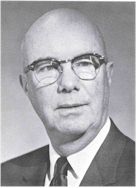Wilmer Barrow
- Birthdate
- 1903/10/25
- Birthplace
- Baton Rouge, LA, USA
- Death date
- 1975/08/30
- Associated organizations
- MIT
- Fields of study
- Radio, Radar
- Awards
- IEEE Edison Medal, Morris N. Liebmann Memorial Prize
Biography
Wilmer Barrow, who was called “Zike” by some of his colleagues, was born in Baton Rouge, Louisiana, in 1903. As a youngster, Barrow was excited as a youngster by news of the early role of wireless telegraphy in sea rescue operations and a vision of the vast potentiality of long-distance communication filled his life. He started in the Amateur Radio Relay League in the era of rotary spark gaps, crystal detectors and the de Forest Audion. These interests led him to a BSEE degree in 1926 from Louisiana State University. He then continued graduate work at MIT and the Technische Hochshule in Munich. In Germany, as a Redfield Proctor Fellow in physics he studied under the famous Jonathan Zenneck and Arnold Summerfeld. For his graduate work, he was awarded an M.S. degree in Electrical Communications from MIT in 1929, and a D.Sc. in physics in Germany in 1931.
Returning to the staff of MIT as an instructor in Electrical Engineering and Communications, he served also under Dr. Julius Stratton with the MIT Round Hill Research Group seeking a practical short-wave radio method for landing aircraft under poor visibility conditions. In this search he developed a theory to show how electromagnetic waves could be propagated along the inside of hollow metal tubes and then be radiated from a metal horn. He and his students then devised pioneering experimental techniques to extend the theory to practice. In the process they invented many of the microwave structures which were so valuable to the explosive development and production of microwave radar prior to, during, and since World War II.
Dr. Barrow served 12 years on the MIT faculty, being promoted to assistant professor in 1936 and associate professor in 1941. He was an original member of the MIT Radiation Laboratory, and was chosen to establish and direct the now-famous MIT Radar School. While at MIT, he joined with others in writing a series of text books for the Electrical Engineering Staff. He wrote over two dozen papers based on his own research and had over a score of patents issued on his inventions.
After 1941 he served the armed forces in a number of advisory capacities. He acted as chairman of the Technical Consulting Group, Committee on Guided Missiles, Research and Development Board of the Department of Defense. His membership in the National Defense Research Council during World War II earned him a presidential citation "in recognition of...outstanding services...in the field of microwave radar development, which proved to be an invaluable contribution to the war efforts of the United States and its Allies." For several years he was a member of the Polaris Missile Steering Task Group, for which he received a citation from the Secretary of the Navy.
In 1970, Dr. Barrow ended his career as vice president for research and development of the Sperry Gyroscope Company. He had risen to that position after 26 years of varied engineering, research and development assignments covering every aspect of Sperry's broad-based scientific and technical activities. Equal in importance to his own roster of achievements were the contributions Dr. Barrow made to the growth of many others in the profession. Those who worked with him-students, government planners, and industrial research colleagues alike-- benefited greatly from his rare combination of technical competence, personal warmth and charm, his management skills, vision and imagination.
Dr. Barrow participated in IRE and IEEE affairs for over 30 years. He was a member of the IRE Board of Directors in 1943-45 and was on 15 national committees, including the Board of Editors and the Radio Technical Planning Board. He was chairman of the Boston Section in 1939-41, during which time he brought the national convention to Boston and served as its general chairman. He was elected to the grade of Fellow in the IRE in 1941 for his early contributions in microwaves, earning laurels "for pioneering investigation of ultra-high frequency wave propagation and many of its practical applications." Two years later he received the Morris N. Liebmann Memorial Prize of the IRE for work in the same field. He was also a Fellow of the American Academy of Arts and Sciences, and a member of Sigma Xi. In 1966 he was awarded the IEEE Edison Medal “For a career of meritorious achievement-innovating, teaching and developing means for transmission of electromagnetic energy at microwave frequencies.”
Dr. Barrow married Katherine Weatherby Burke in 1928. They had two daughters and six grandchildren. He died, in New Hampshire, on 30 August 1975.
